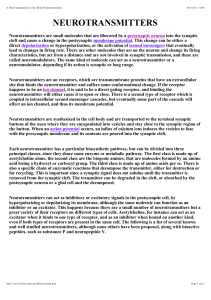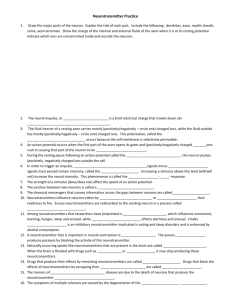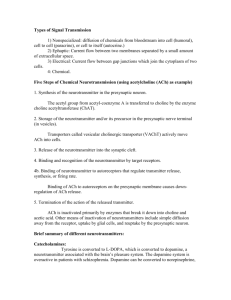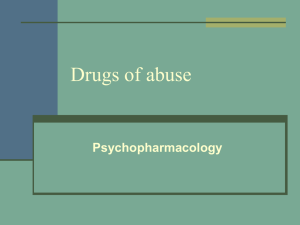The following will describe the role of neurotransmitters in bodily
advertisement
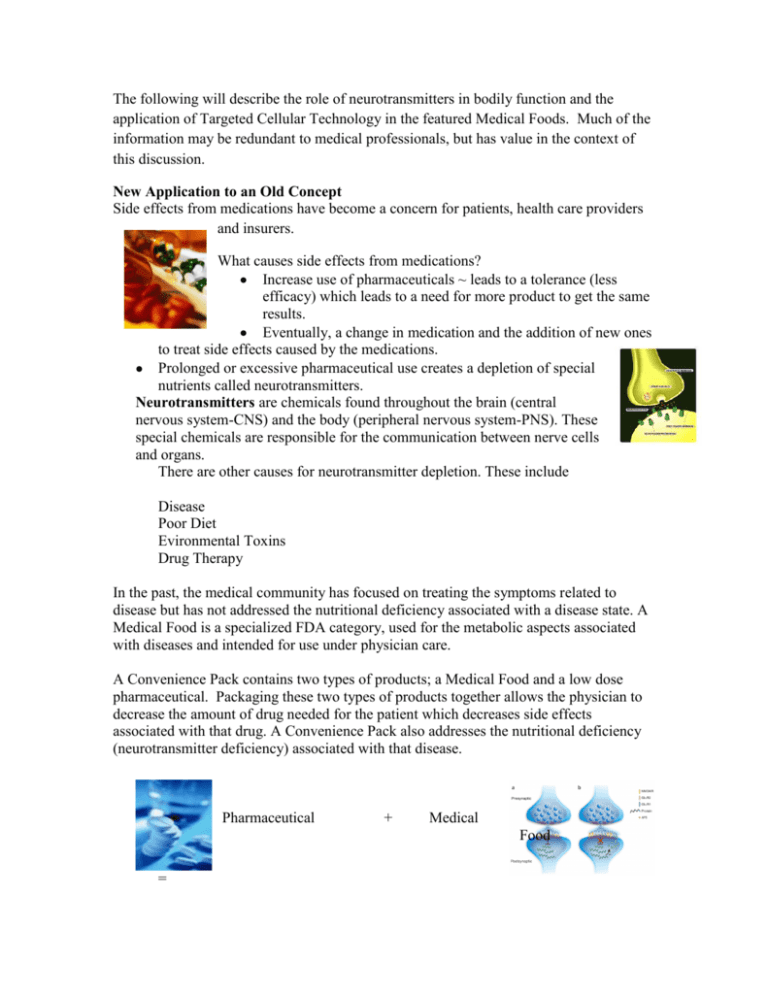
The following will describe the role of neurotransmitters in bodily function and the application of Targeted Cellular Technology in the featured Medical Foods. Much of the information may be redundant to medical professionals, but has value in the context of this discussion. New Application to an Old Concept Side effects from medications have become a concern for patients, health care providers and insurers. What causes side effects from medications? Increase use of pharmaceuticals ~ leads to a tolerance (less efficacy) which leads to a need for more product to get the same results. Eventually, a change in medication and the addition of new ones to treat side effects caused by the medications. Prolonged or excessive pharmaceutical use creates a depletion of special nutrients called neurotransmitters. Neurotransmitters are chemicals found throughout the brain (central nervous system-CNS) and the body (peripheral nervous system-PNS). These special chemicals are responsible for the communication between nerve cells and organs. There are other causes for neurotransmitter depletion. These include Disease Poor Diet Evironmental Toxins Drug Therapy In the past, the medical community has focused on treating the symptoms related to disease but has not addressed the nutritional deficiency associated with a disease state. A Medical Food is a specialized FDA category, used for the metabolic aspects associated with diseases and intended for use under physician care. A Convenience Pack contains two types of products; a Medical Food and a low dose pharmaceutical. Packaging these two types of products together allows the physician to decrease the amount of drug needed for the patient which decreases side effects associated with that drug. A Convenience Pack also addresses the nutritional deficiency (neurotransmitter deficiency) associated with that disease. Pharmaceutical + Medical Food = Treating symptoms with less drug while addressing the nutritional deficiency associated with that disease. Not all Medical Foods are alike. Medical Foods that are manufactured by Physician Therapeutics use a patented technology known as Targeted Cellular Technology or TCT. TCT consists of five components. Neurotransmission A neurotransmitter precursor An uptake stimulator A neuron activator An adenosine break releaser An attenuation inhibitor Production of Release of Neurotransmitter Neurotransmitter This technology allows for milligram quantities of amino acid to be converted into a neurotransmitter, released by the neuron and taken back up into the pre-synaptic cell to be stored for re-use. This process is broken down when a person takes too many pharmaceutical drugs, is exposed to environmental toxins, is in a diseased state or has a poor or unhealthy diet. Medical Foods replenish the cell with the metabolites it is lacking that are involved in the disease process. Pharmaceutical and Medical Food Convenience Packs for Nutritional Deficiencies and Disease States There has been increasing attention to the role that neurotransmitters and neuromodulators play in various aspects of health and disease. Neurotransmitters are the chemical messengers that allow one neuron to communicate with other neurons or an effector organ. Some examples of classic neurotransmitters are acetylcholine and norepinephrine that function within the autonomic nervous system. The autonomic nervous system, operating through its neurotransmitters, controls important body functions, such as heart rate, respiratory rate, gastrointestinal function, appetite, sleep, sexual performance, blood pressure, and mood. Additionally, neurotransmitters and neuromodulators play a crucial role in regulating the function of the cardiovascular, reproductive, musculoskeletal, immune, respiratory, and memory systems. Numerous pharmaceutical agents have been developed that exert their effects by interfering with one or more of these neurotransmitter or neuromodulator systems. One important pharmaceutical mechanism is that of reuptake inhibition of neurotransmitters in the synaptic cleft of neuron junctions. The pharmaceuticals fluoxetine and fenfluramine are examples of neurotransmitter reuptake inhibitors. All known neurotransmitters are synthesized within the neurons from their requisite precursor molecules. Administration of neurotransmitter and neuromodulator precursors to subjects has long been known to induce a physiologic response. For example, administration of tryptophan – the precursor to the neurotransmitter serotonin – leads to the production of serotonin, administration of choline leads to the production of acetylcholine, administration of tyrosine leads to the production of epinephrine, and administration of arginine leads to the production of nitric oxide. These precursor molecules are generally amino acids and are produced in the liver or are derived from the diet. Although, the administration of neurotransmitter precursors is known to acutely produce neurotransmitters, as evidenced by a physiologic response, the physiologic response induced by administration of a precursor to a neurotransmitter is often inconsistent, weak in magnitude and attenuates rapidly such that the precursor administration is largely ineffective. The physiologic loss of neurotransmitter function results in abnormal physiology that either initiates a disease or promotes its severity. Specialized Proprietary Process Enhances Neurotransmitter Production Product formulations, all based upon a proprietary Targeted Cellular Technology™ (“TCT”) platform, allow reduced concentrations of amino acids to generate effective amounts of nerve and brain cell messengers called neurotransmitters. Amino acids are the building blocks from which the body produces these neurotransmitters, the critical chemical messengers that regulate most bodily functions. Increasing neurotransmitter production allows for improved sleep quality, improved cognitive function, mitigation of pain, blood pressure regulation, improved lung function, appetite regulation, or amelioration of complex medical syndromes all with minimal potential for adverse effects. TMP products mirror pharmaceutical responses by addressing underlying nutritional deficiencies of disease states and can be taken alone or with reduced doses of pharmaceuticals under medical supervision. The following examples illustrate formulations that produce the desired effect with the lowest FDA approved dose of a pharmaceutical. Neurotransmitters, Brain Function and Disease A. Neurons: Highly specialized cells that generate and transmit messages from one part of the body to another; the functional unit of the nervous system. A cell of the nerve that receives messages is called dendrites and the zone of a nerve that transmits a message is called an axon (of varying length). The electrochemical nerve impulse/message is transmitted by neurons. Synaptic cleft The space between the end of a neuron and an adjacent cell B. Divisions of the Nervous System The nervous system monitors and controls almost every organ system through a series of positive and negative feedback loops. The Central Nervous System (CNS) includes the brain and spinal cord. The Peripheral Nervous System (PNS) connects the CNS to other parts of the body, and is composed of nerves (bundles of neurons). Autonomic Nervous system - The portion of the peripheral nervous system that stimulates smooth muscle, cardiac muscle, and glands; consists of the parasympathetic and sympathetic systems. Parasympathetic system - The subdivision of the autonomic nervous system that reverses the effects of the sympathetic nervous system. Part of the autonomic nervous system that controls heartbeat, respiration and other vital functions. Sympathetic system - The subdivision of the autonomic nervous system that dominates in stressful or emergency situations and prepares the body for strenuous physical activity, e.g., causing the heart to beat faster. C. Neurotransmitters--The Body's Chemical Signals Chemicals released from the tip of an axon into the synaptic cleft (space between two cells or a cell and an organ) when a nerve impulse arrives; may stimulate or inhibit the next neuron. The chemical that crosses the synaptic cleft and causes the transmission of the nerve message in an adjacent neuron or the stimulation of an effector cell (muscle or gland) is referred to as a neurotransmitter. Neurotransmitters are the messengers from the brain to the peripheral nerves. Neurotransmitters are the bodies signaling systems-- they are the red, yellow and green lights. The release of neurotransmitters targets muscles and glands throughout the body. Neurotoxin: Chemical that paralyzes nerves Types of Neurotransmitters There are seven primary neurotransmitters and approximately 32 other neuromodulators. The primary neurotransmitters are: Acetylcholine –the most abundant neurotransmitter in the body. Involved in memory and brain functioning, increases muscle function and increases REM sleep. Norepinephrine – an excitatory neurotransmitter. Decreases appetite, increases heart rate and enhances mood. A catecholamine. Dopamine - an excitatory neurotransmitter. Decreases appetite, increases heart rate and enhances mood. A catecholamine GABA & Glycine – inhibitory neurotransmitters. Serotonin – initiates sleep. Inhibits eating and pain. Enhances mood (used to manage depression. Histamine – suppresses appetite, used in response to inflammation. Nitric Oxide – increases blood vessel health, decreases blood pressure (but not too low) utilizes blood glucose (sugar), enhances effects of Viagra. Glutamate – the most abundant excitatory neurotransmitter in the brain (CNS). D. Symptoms Associated with Neurotransmitter Depletion Neurotransmitters control all of the automatic function of the body including heart rate, breathing rate, mood, sleep, body temperature, memory, mental acuity, and muscle strength. A deficiency of any of the neurotransmitters can cause a variety of symptoms. In general, the symptoms associated with neurotransmitter deficiencies include: Memory Loss Muscle Weakness General Fatigue Sleeplessness Anxiety/Panic Depression Osteoarthritis Leg Pain Diabetes High Blood Pressure Excessive Appetite and Weight Gain E. Sources of Neurotransmitters Diet -- Neurotransmitters are produced by the brain and nerve cells from precursor molecules. Usually the precursors are molecules called amino acids. The amino acids are the building blocks of the body and are the components of proteins. There are twenty-two amino acids. Several of the amino acids, particularly the precursors of important neurotransmitters, are relatively uncommon in the diet and cannot be made in sufficient amounts. Thus, the wrong diet can cause a precursor deficiency and symptoms of neurotransmitter deficiency. Replacement of the right neurotransmitter building blocks can be used to repair the effects of inadequate diet, just as vitamins are used to replenish nutrient sources that the modern diet does not provide. Stress--Stress depletes neurotransmitters!! Any type of stress---lack of sleep, anger, anxiety, depression, illness, and pain can cause depletion of important neurotransmitters. Stress can cause the symptoms of neurotransmitter deficiency. Stress can cause sleeplessness, sexual dysfunction, immune system dysfunction and weight gain. Replenishment of neurotransmitters can reduce the symptoms of neurotransmitter deficiency. Disease--Many diseases deplete neurotransmitters in the brain and the peripheral nerves. These diseases include: Memory Disorders Panic disorders Sleep disorders Insomnia Alzheimer's Disease Depression Toxin Induced Organic Brain Syndromes Diabetic Neuropathy Fibromyalgia Acute and Chronic Pain Syndromes Herpes Simplex Herpes Zoster Retrovirus Disease Osteoarthritis This is not an all-inclusive list of diseases that influence neurotransmitter function. Neurotransmitters are the body's central communication system. It should not be surprising that many diseases influence the body’s internal communication system. Science, in the last 10 years has shown us how the body communicates and how disease influences these vital systems. Medical Foods can now be used to target neurotransmitter deficiencies, fix them and help restore internal balance without drugs. Pharmaceutical Agents: Drugs, both legal and illegal drugs, can cause neurotransmitter depletion. The longer a person uses a drug, the more depletion, dysfunction and nerve cell death occurs. In addition, desensitization will occur on the cell, causing the drug to be less effective and therefore requiring the need to increase the dose or change types of medication. How Can Neurotransmitter Deficiency be Restored? Neurotransmitter production by the brain is dependent on the right sources of building blocks from the diet. In general, neurotransmitters are made from molecules called amino acids. Amino acids are combined by all livings things into proteins but are also used to produce the messenger system, the neurotransmitters. There are twenty-two amino acids that are used by the human body. The body can make most of these amino acids from sugar and fat. There are, however, certain key amino acids that the body cannot produce or can only produce in small amounts. For these key amino acids, shortages in supply lead to shortages of the neurotransmitters. The shortages of the neurotransmitters lead to symptoms of many diseases. For example, the body has difficulty making enough Serotonin, a key neurotransmitter associated with appetite, mood and sleep. Serotonin is made from an amino acid known as tryptophan. Tryptophan is one of the rare amino acids in the food we eat. The body cannot make tryptophan. Stress rapidly depletes tryptophan. To get adequate tryptophan in the diet you must eat large amounts of protein, particularly animal protein. Eating large amount of animal protein results in unwanted weight gain and increased blood cholesterol. Recent medical advice to reduce the intake of animal proteins, particularly meat, has lead to a chronic shortage of tryptophan in the diet. Thus, reduced tryptophan leads to reduced Serotonin. Reduced Serotonin leads to depression, inability to sleep, anxiety, panic spells, and increased hunger with weight gain. Another example involves the neurotransmitter acetylcholine. Acetylcholine is the most important neurotransmitter in the body. Acetylcholine controls breathing, heart rate, blood pressure, deep sleep, sexual performance, the immune system and muscle strength. Without adequate production of acetylcholine by an area in the brain called the hippocampus, you cannot get restful sleep. Inadequate Acetylcholine production has been shown to be an important component of memory disorders and is thought to contribute to the development of Alzheimer's disease. Inadequate dietary choline results in reduced production of acetylcholine--memory problems, sleep problems, sexual problems and muscle fatigue result. The brain and nerve cells cannot make choline-- they depend on adequate dietary sources of this key compound. Since diet alone, particularly highly purified diets cannot provide adequate amounts of the key amino acids; supplementation or treatment with targeted Medical Foods can help treat the symptoms associated with neurotransmitter deficiency. In the past, we have focused on vitamin supplementation therapies, but neurotransmitter deficiencies have not received the same attention. Merely taking amino acid supplements is not enough, however. If you take all of the amino acids at the same time, they will compete with each other for brain and nerve absorption. In order to use the amino acids as therapies for symptoms, you must target them. You must know the specific symptom, the specific disease, and the specific patient. The combination of the right neurotransmitter precursor, specific potentiators and activators is necessary to elicit the right effect. These amino acid based products are designed for sleep disorders. Science, over the last 20 years has shown us the importance of neurotransmitters in health and disease. Clinicians are just beginning to apply this knowledge to symptoms of neurotransmitter deficiency. We are fortunate that these symptoms and their underlying disease states can be treated with natural products instead of drugs.


